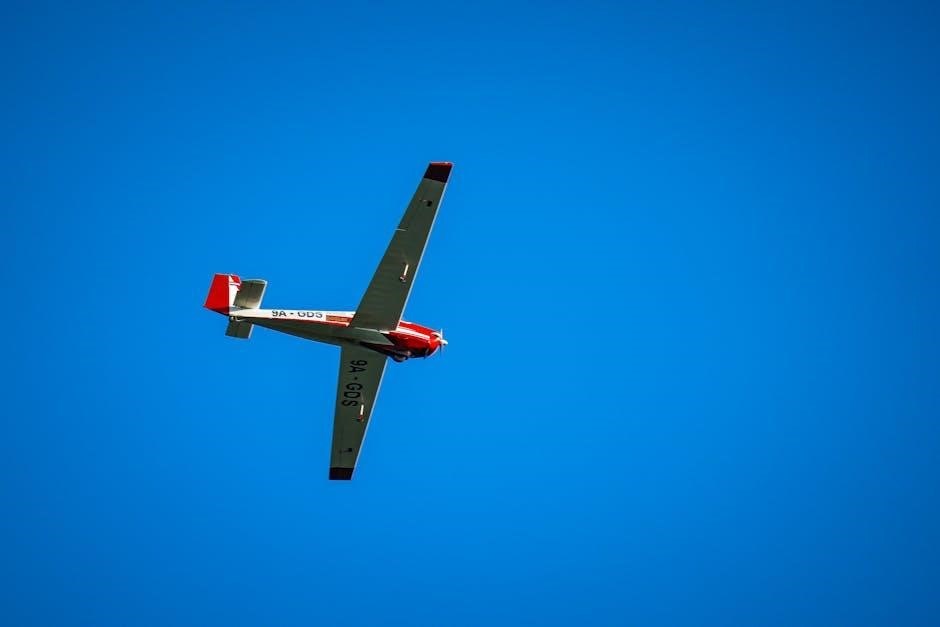Quicksilver propellers are renowned for their exceptional performance, durability, and innovative design, offering customized solutions for various marine applications․ They deliver superior efficiency and reliability, making them a top choice for boating enthusiasts․
1․1 History of Quicksilver Propellers
Quicksilver Propellers, a trusted name in marine propulsion, has a rich history dating back to its establishment as a leading manufacturer of high-performance propellers․ Since its inception, the brand has been synonymous with innovation, quality, and reliability․ Known for their durable construction and precision engineering, Quicksilver propellers have evolved over the years to meet the changing needs of boaters․ Their commitment to advancing propeller technology has earned them a reputation as a go-to choice for both recreational and professional marine applications․ With a focus on delivering exceptional performance and efficiency, Quicksilver Propellers continues to be a benchmark in the industry, offering tailored solutions for diverse boating requirements worldwide․
1․2 Evolution of Quicksilver Propeller Design
Quicksilver Propeller design has undergone significant advancements over the years, driven by cutting-edge technology and a deep understanding of marine dynamics․ Early designs focused on durability and basic performance, but modern iterations incorporate sophisticated engineering to optimize efficiency and versatility․ The introduction of high-quality materials, such as stainless steel and aluminum, has enhanced strength and corrosion resistance․ Additionally, Quicksilver Propellers now feature customizable pitch options, allowing boaters to tailor their propellers to specific applications, from cruising to high-speed performance․ These design evolutions ensure that Quicksilver Propellers meet the diverse needs of today’s boating enthusiasts, delivering enhanced fuel efficiency, reduced vibration, and improved handling․ Continuous innovation has solidified their reputation as a leader in marine propulsion solutions․
1․3 Benefits of Using Quicksilver Propellers
Quicksilver Propellers offer numerous advantages, making them a top choice for boaters seeking enhanced performance and reliability․ Their designs optimize fuel efficiency, reducing consumption while maintaining speed․ Customizable options allow users to tailor propellers to specific needs, whether for cruising or high-speed applications․ High-quality materials ensure durability, withstanding harsh marine conditions and extending lifespan․ Additionally, Quicksilver Propellers are designed to minimize vibration, providing a smoother ride and reducing engine strain․ Their compatibility with various boat types and engines makes them versatile solutions․ Furthermore, the availability of tools like the Mercury Propeller Finder simplifies selection, ensuring optimal performance․ Overall, Quicksilver Propellers deliver a combination of efficiency, reliability, and customization, making them a preferred choice for maritime enthusiasts․

Understanding Propeller Basics
A propeller converts engine power into thrust by pushing water backward, essential for boat movement․ Its design, including pitch and diameter, significantly impacts performance and efficiency․
2․1 What is a Propeller and How Does it Work?
A propeller is a spinning device with angled blades that convert engine power into thrust by pushing water backward․ As the propeller rotates, its blades generate lift, creating forward motion․ The design of the blades, including pitch and diameter, determines how efficiently the propeller operates․ Pitch refers to the angle of the blade, which influences how much water it moves with each rotation․ A larger diameter typically moves more water, while a smaller pitch increases speed․ Proper alignment and balance are crucial for optimal performance․ Understanding how a propeller works is essential for selecting the right one for your boat, ensuring efficient fuel use and maximizing speed or torque based on your needs․
2․2 Key Components of a Propeller

A propeller consists of several critical components that work together to ensure efficient operation․ The hub is the central part that attaches to the propeller shaft and holds the blades in place․ The blades are the spinning parts that create thrust by pushing water backward․ Blade design, including pitch and rake, significantly impacts performance․ The shaft connects the propeller to the engine, transmitting power․ Other key elements include the pitch, which determines how much water the propeller moves with each rotation, and the diameter, which affects the volume of water displaced․ Proper alignment and balance of these components are essential for optimal efficiency, reducing vibration and noise․ Understanding these parts helps in selecting and maintaining the right propeller for your boat․
2․3 Importance of Propeller Pitch and Diameter
Propeller pitch and diameter are critical factors in determining performance․ The pitch refers to the angle of the blade, which influences how much water the propeller moves with each rotation․ A higher pitch typically results in higher speeds but may reduce acceleration, while a lower pitch improves maneuverability and hole-shot․ The diameter is the distance across the propeller’s circle and affects thrust and efficiency․ A larger diameter generally increases thrust but may require more power․ Balancing these elements ensures optimal performance for your boat’s specific needs․ Proper pitch and diameter selection are essential for achieving the desired speed, fuel efficiency, and overall boat handling․ They must align with the engine’s RPM range and the boat’s intended use to maximize efficiency and minimize wear on the engine and propeller system․

Selecting the Right Quicksilver Propeller
Selecting the right Quicksilver propeller involves considering engine RPM, boat usage, and performance goals․ Use tools like the Mercury Propeller Finder Tool for optimal fit and efficiency․
3․1 How to Determine the Correct Propeller Size
To determine the correct Quicksilver propeller size, consider your boat’s specific needs, including engine RPM, gear ratio, and intended use․ Start by understanding the theoretical speed formula: (pitch x RPM)/(gear ratio x 1056)․ This calculation helps estimate your boat’s potential speed․ Next, use tools like the Mercury Propeller Finder Tool, which requires inputting your engine’s horsepower, RPM, and gear ratio․ Additionally, factors such as boat weight, hull design, and typical operating conditions (e․g․, cruising or towing) play a role․ Testing different propellers under real-world conditions is often necessary to find the optimal size․ Always consult the manufacturer’s guidelines and seek professional advice if unsure․
3․2 Factors to Consider for Optimal Performance
For optimal performance with a Quicksilver propeller, consider several key factors․ First, engine RPM is crucial; ensure the propeller allows your engine to operate within the recommended RPM range at wide-open throttle․ Gear ratio also plays a significant role, as it affects the torque delivered to the propeller․ Boat weight and load are essential, as a heavier load may require a different pitch․ Hull design influences how efficiently the propeller engages the water․ Additionally, operating conditions, such as freshwater or saltwater use, can impact propeller durability․ Finally, cruising speed versus top speed should be balanced based on your boating priorities․ By evaluating these factors, you can select a propeller that maximizes both efficiency and performance for your specific needs․
3․3 Using the Mercury Propeller Finder Tool
The Mercury Propeller Finder Tool simplifies the process of selecting the ideal Quicksilver propeller for your boat․ By inputting specific details such as engine type, gear ratio, current propeller pitch, and maximum RPM, the tool provides tailored recommendations․ Start by visiting Mercury’s official website and navigating to the Propeller Finder section․ Enter your boat’s make, model, and year, along with your outboard motor’s horsepower and current propeller specifications․ The tool will analyze this data and suggest compatible Quicksilver propellers optimized for your vessel’s performance needs․ This resource ensures a precise match, enhancing your boating experience by improving efficiency, speed, and overall satisfaction․

Installation and Maintenance

Proper installation and regular maintenance ensure optimal performance and longevity of Quicksilver propellers․ Always follow manufacturer guidelines for alignment, fastening, and inspections to prevent damage and ensure safety․
4․1 Step-by-Step Installation Guide
Installing a Quicksilver propeller requires careful attention to detail to ensure proper function and safety․ Begin by gathering all necessary tools and components, including the propeller, hub, and hardware․ Ensure the outboard or sterndrive is in neutral and the area is clear of debris․ Align the propeller shaft with the hub, securing it with the provided hardware․ Tighten all bolts in a star pattern to avoid warping the hub․ Double-check the alignment to prevent vibration issues․ Lubricate moving parts as specified by the manufacturer․ Finally, test the installation by running the engine at low RPM in a controlled environment to ensure smooth operation and no unusual noise or vibration․
4;2 Maintenance Tips for Longevity
Regular maintenance is crucial to extending the life of your Quicksilver propeller․ Start by cleaning the propeller thoroughly after each use, removing dirt, algae, and debris that can cause corrosion․ Inspect the blades for dings, scratches, or bends, addressing any damage promptly to prevent further issues․ Apply a marine-grade protective coating to shield against corrosion․ Avoid using abrasive materials that could scratch the surface․ After exposure to saltwater, rinse the propeller with freshwater to prevent mineral buildup․ Store the propeller in a dry, protected area during off-seasons․ Following these steps ensures optimal performance, reduces wear, and maintains your propeller’s efficiency for years to come․
4․3 Troubleshooting Common Issues
Identifying and addressing issues with your Quicksilver propeller is essential for maintaining performance․ Vibration or noise often indicates misalignment, damaged blades, or improper installation․ Inspect the propeller hub and blades for dents or bends, and ensure the propeller is securely fastened․ Cavitation, characterized by a bubbly water flow, can result from incorrect pitch or diameter․ Adjusting the propeller or consulting a professional may resolve this․ Corrosion is another common issue, especially in saltwater environments․ Regular cleaning and applying a protective coating can prevent this․ If damage is severe, consider refurbishing or replacing the propeller․ Promptly addressing these issues ensures smoother operation, reduces wear, and maintains your propeller’s efficiency over time․

Performance Optimization
Optimizing your Quicksilver propeller involves tuning for maximum efficiency, monitoring RPM, and adjusting pitch to match your engine’s capabilities․ Proper alignment and regular maintenance ensure peak performance and fuel efficiency․
5․1 Tuning Your Propeller for Maximum Efficiency
Tuning your Quicksilver propeller for maximum efficiency involves understanding the relationship between pitch, RPM, and engine performance․ Start by ensuring the propeller’s pitch matches your engine’s specifications․ A higher pitch can increase speed but may reduce acceleration, while a lower pitch enhances acceleration at the cost of top speed․ Use the Mercury Propeller Finder Tool to determine the ideal pitch for your setup․ Additionally, monitor your engine’s RPM at wide-open throttle; it should fall within the recommended range․ Adjustments may require trial and error, so keep track of performance metrics like speed and fuel efficiency․ Regular maintenance, such as cleaning and balancing the propeller, also plays a crucial role in maintaining efficiency․ By fine-tuning these elements, you can optimize your propeller’s performance for your specific boating needs․
5․2 Understanding Propeller RPM and Speed
Propeller RPM (Revolutions Per Minute) and speed are critical factors in optimizing your boat’s performance․ The theoretical speed of your boat can be calculated using the formula: (pitch x RPM) / (gear ratio x 1056)․ This helps determine whether your current propeller setup is achieving the desired performance․ Monitoring RPM at wide-open throttle ensures your engine operates within the recommended range, typically between 4,200 and 4,600 RPM for many outboards․ Higher RPM generally correlates with greater speed, but excessive RPM can lead to inefficiency or engine strain․ Use tools like the Mercury Propeller Finder to match your propeller size and pitch to your engine’s specifications for optimal RPM and speed․ Balancing these elements ensures your boat runs efficiently and effectively for your specific boating needs․
5․3 Enhancing Fuel Efficiency with the Right Propeller
Enhancing fuel efficiency with the right propeller involves balancing size, pitch, and design to match your boat’s specific needs․ A propeller with the correct pitch ensures your engine operates within its optimal RPM range, reducing fuel consumption․ Larger diameters can improve efficiency at lower speeds, while smaller diameters excel at higher speeds․ Using tools like the Mercury Propeller Finder helps identify the ideal propeller for your setup․ Proper alignment of propeller specifications with your engine’s capabilities minimizes drag and maximizes fuel economy․ Additionally, maintaining your propeller through regular cleaning and inspections ensures it performs optimally, further enhancing fuel efficiency․ By selecting the right propeller and maintaining it well, you can significantly reduce fuel costs and improve your boating experience․

Advanced Propeller Customization
Advanced propeller customization offers tailored solutions for specific boating needs, allowing modifications in pitch, diameter, and design to enhance performance and efficiency․ Skilled technicians can craft custom propellers to meet individual preferences and operational demands, ensuring optimal results․

6․1 Custom Pitch and Diameter Modifications
Customizing a Quicksilver propeller involves adjusting its pitch and diameter to suit specific performance needs․ Pitch refers to the angle of the blade, influencing speed and torque, while diameter affects the overall efficiency․ By modifying these elements, boaters can optimize their propeller for various conditions, such as cruising or high-speed operations․ Skilled technicians use advanced tools to precision-craft these modifications, ensuring the propeller operates at peak performance․ This level of customization allows for enhanced fuel efficiency, improved handling, and increased overall satisfaction with the vessel’s performance․ Whether for racing, fishing, or recreational use, tailored pitch and diameter adjustments ensure the propeller meets the exact demands of the application․
6․2 Balancing and Refurbishing Your Propeller
Maintaining your Quicksilver propeller’s performance involves regular balancing and refurbishing․ Over time, propellers can develop imbalances due to wear or damage, leading to vibration and reduced efficiency․ Professional technicians use specialized equipment to restore balance, ensuring smooth operation and minimizing wear on the engine․ Refurbishing may include repitching, repairing nicks, and recoating the blades to maintain their optimal shape and surface finish․ Proper balancing and refurbishing not only enhance performance but also extend the propeller’s lifespan․ Regular maintenance checks are crucial to identify issues early, preventing costly repairs and ensuring your propeller operates at its best for years to come․ A well-maintained propeller contributes to better fuel efficiency, reduced noise, and improved overall boating experience․
6․3 Upgrading to High-Performance Propellers
Upgrading to high-performance Quicksilver propellers can significantly enhance your boat’s speed, acceleration, and overall efficiency․ These propellers are designed with advanced blade geometries and materials to maximize thrust while minimizing drag․ High-performance models often feature optimized pitch and diameter combinations tailored to specific engine types and boating conditions․ Whether you prioritize top speed, fuel efficiency, or versatility, there’s a propeller design to meet your needs․ Upgrading not only improves performance but also ensures compatibility with your engine, reducing wear and tear․ Consider factors like operating conditions, load capacity, and intended use when selecting a high-performance propeller․ Consulting with a propeller specialist can help you choose the best option for your vessel, ensuring a seamless upgrade and optimal results on the water․

Troubleshooting Common Problems
Identifying propeller issues early prevents costly damages․ Common problems include vibration, noise, or reduced performance․ Addressing these involves inspecting for damage, balancing, or adjusting pitch․ Use diagnostic tools like the Mercury Propeller Finder to identify and resolve issues effectively, ensuring optimal boat performance and longevity․
7․1 Diagnosing Propeller-Related Issues
Diagnosing propeller-related issues starts with observing performance changes․ Look for signs like vibration, noise, or decreased speed․ Inspect the propeller for visible damage, dents, or corrosion․ Check the hub for proper installation and alignment․ Record engine RPM at wide-open throttle to ensure it falls within the recommended range․ Compare current performance with the manufacturer’s specifications․ Use tools like the Mercury Propeller Finder to identify potential mismatches in pitch or diameter․ Consult the Mercury Outboard Parts Catalog for reference․ Addressing these issues early prevents further damage and ensures optimal boat performance․ Regular inspection and maintenance are key to extending propeller longevity and efficiency․
7․2 Addressing Vibration and Noise Problems
Vibration and noise issues often stem from improper propeller alignment or damage․ Start by inspecting the propeller for dents, bends, or corrosion․ Ensure the hub is securely fastened and properly aligned with the engine․ Check the propeller shaft for wobble or misalignment․ If issues persist, consider rebalancing or refurbishing the propeller․ Use tools like the Mercury Propeller Finder to verify the correct pitch and diameter for your setup․ Refer to the Mercury Outboard Parts Catalog for specifications․ Addressing these problems early prevents further damage to the engine or drive system․ Regular maintenance and inspections are crucial for maintaining smooth operation and minimizing noise․
7․3 Repairing Damage to Your Quicksilver Propeller
Repairing a damaged Quicksilver propeller requires careful assessment and precision․ Start by inspecting the propeller for dents, cracks, or bent blades․ Minor damage, such as small nicks or dings, can often be repaired through polishing or filing․ However, more severe damage may necessitate professional refurbishment or blade replacement․ Always ensure repairs are done by a certified technician to maintain performance and safety․ For extensive damage, consider upgrading to a high-performance propeller․ Use the Mercury Propeller Finder to identify the correct replacement for your engine․ Regular inspections and timely repairs can prevent further deterioration and ensure optimal efficiency․ Refer to the Mercury Outboard Parts Catalog for specific repair guidelines and parts compatibility․
Quicksilver propellers offer exceptional performance and durability, making them a top choice for boating enthusiasts․ Proper selection, maintenance, and repair ensure longevity and optimal efficiency․ Use the Mercury Propeller Finder for the best results․
8․1 Final Thoughts on Quicksilver Propellers
Quicksilver propellers are a top-tier choice for boating enthusiasts, offering exceptional performance, durability, and customization options․ Their innovative designs ensure optimal efficiency, whether for cruising or high-speed applications․ By leveraging tools like the Mercury Propeller Finder, users can select the perfect propeller for their specific needs, balancing factors like pitch, diameter, and RPM․ Proper installation and regular maintenance are key to maximizing longevity and performance․ Customization options, such as pitch modifications and balancing, further enhance their versatility․ With a focus on quality and reliability, Quicksilver propellers remain a trusted choice for boat owners seeking to optimize their on-water experience․
8․2 Best Practices for Future Maintenance
Regular maintenance is essential to ensure the longevity and performance of your Quicksilver propeller․ Inspect the propeller after each use for signs of damage, such as dings or corrosion․ Clean the propeller thoroughly to remove debris and marine growth, which can hinder efficiency․ Store the propeller in a dry, protected environment during off-season periods to prevent rust․ When performing routine checks, ensure the propeller is properly secured to the hub to avoid vibration issues․ Address any damage promptly by consulting a professional for repairs or replacements․ Additionally, keep a maintenance log to track inspections and servicing, ensuring your propeller remains in optimal condition for years of reliable performance․
8․3 Resources for Further Learning
For those seeking to deepen their knowledge about Quicksilver propellers, several resources are available․ The Mercury Propeller Finder Tool is an excellent starting point, offering personalized recommendations based on your boat’s specifications․ Additionally, West Marine provides comprehensive guides on propeller selection and maintenance․ Online forums like Boat Forums and Reddit’s boating communities are invaluable for connecting with experienced boaters who can share insights and tips․ Manufacturer websites, such as Quicksilver’s official site, often feature detailed technical documentation and FAQs․ Lastly, consider consulting marine hardware stores or certified mechanics for hands-on advice․ These resources collectively provide a wealth of information to help you make informed decisions and optimize your propeller’s performance․
